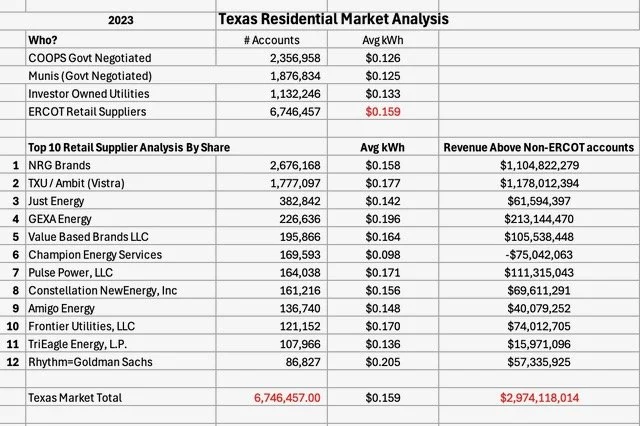Texas Competitive Energy Market Means Higher Power Bills for 7 million Families
Similar to Northeast restructured energy markets, power rates are significantly higher for the Texas “competitive” electricity market.
Texas deregulated its ERCOT market in 2002. About 54% of Texan families (6.8 million households) are serviced by hundreds of retail suppliers. In the Lone Star state’s deregulated market there are no incumbent regulated utilities. These 6.8 million accounts paid on average 15.9 ¢ per kWh.
For residents living in the non-ERCOT market (5.6 million households), there are no retail energy options. Non-ERCOT market families pay electricity rates that are negotiated by one of 62 energy Co-ops or 17 municipalities. Or, these accounts are serviced by one of Texas’ four remaining investor-owned utilities. These 5.6 million accounts paid on average 12.7¢ per kWh.
Families in Texas’ competitive electricity market paid:
3.2 ¢ more per kWh.
About $440 more per family.
$3 billion more in the aggregate in 2023 compared to the non-ERCOT market. See chart below for the Top 12 supplier analysis.
The two dominant players — NRG and Vistra — charged significantly higher rates than non-ERCOT markets.
Together both firms control 66% market share.
Together these 2 mega-energy firms netted $2.2 billion in revenues above non-ERCOT rates.
NRG accounts paid 15.8 ¢ per kWh compared to non-ERCOT 12.7 ¢ per kWh.
Vistra accounts paid 17.7 ¢ per kWh compared to non-ERCOT 12.7 ¢ per kWh.
More about Texas’ competitive energy market:
Since there are no regulated utility price-to-compare rates like in Northeast markets, Texas consumers don’t have a baseline of “what’s a normal kilowatt-hour rate to pay for electricity this period.”
The Texas market has many suppliers yet two firms — NRG and Vistra — own 66% of the accounts making the competitive claim dubious.
Ironically, two of the large pre-deregulation utilities were Reliant and TXU. These utilities and power generators remade themselves into today’s two largest competitive retail suppliers, NRG’s Reliant and Vistra’s TXU.
The average Texan residence uses nearly 14,000 kilowatt hours a year, so an extra 3-5 pennies per kWh matter.
Goldman Sachs owns the “renewable” energy supplier Rhythm Energy. Rhythm recently bought Inspire Energy, too. In 2023 86,000 Rhythm accounts paid on average a whopping 20.5 cents / kWh, nearly 8 cents more than non-ERCOT families. Rhythm’s renewable energy claim is backed by renewable energy certificates (RECs) purchased within ERCOT and nationally for hydro, wind and solar.
The rate charts are based on DOE EIA 861 data.


